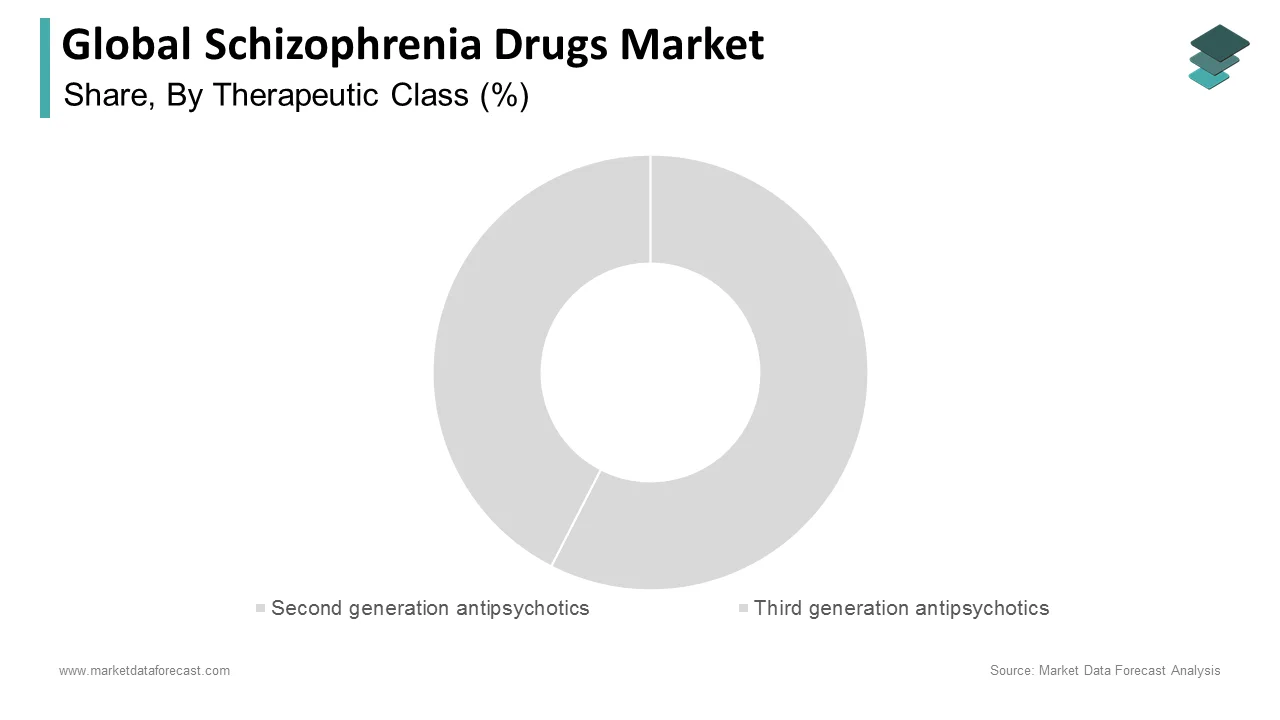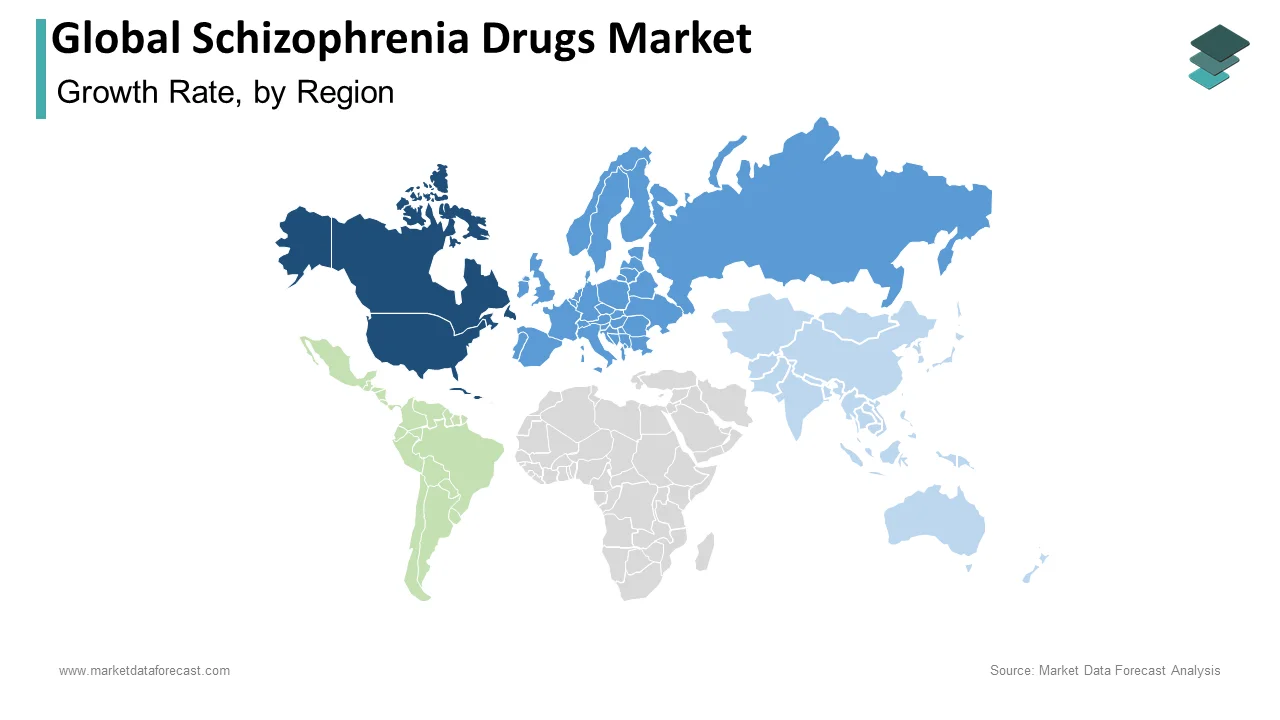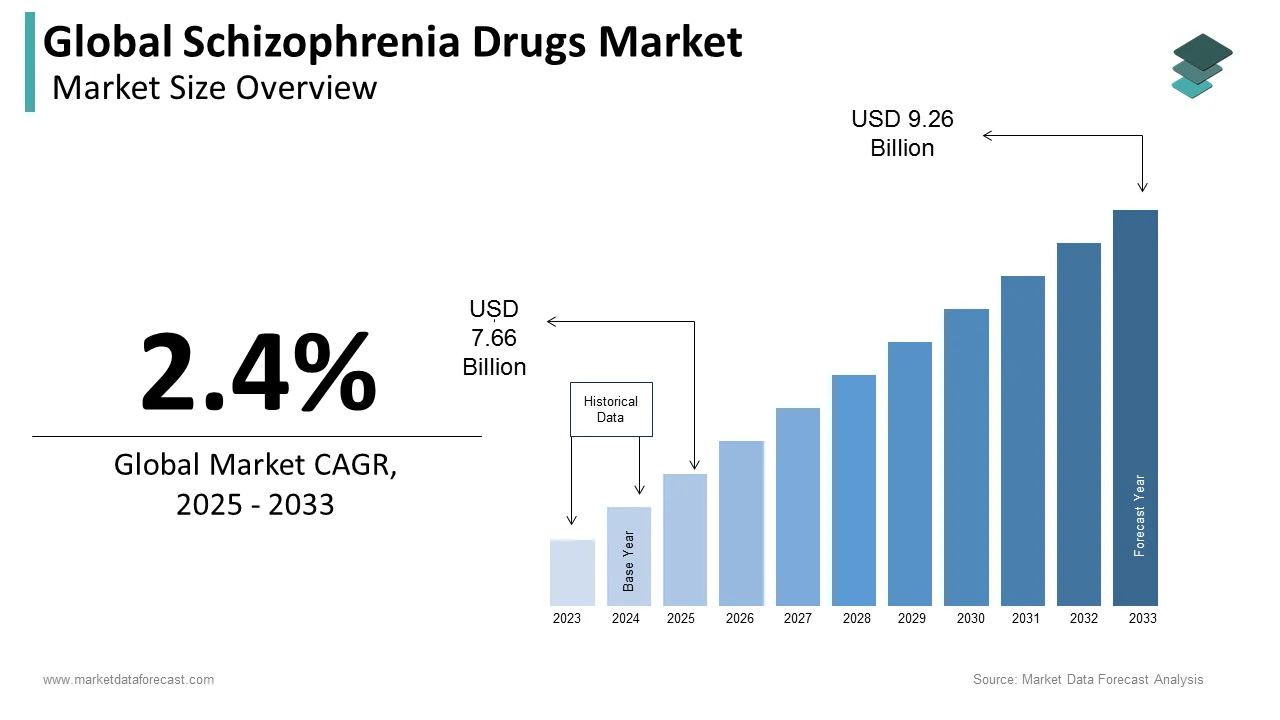Global Schizophrenia Drugs Market Size, Share, Trends & Growth Forecast Report By Therapeutic Class, Treatment and Region (North America, Europe, Asia-Pacific, Latin America, Middle East and Africa), Industry Analysis From 2025 To 2033.
Global Schizophrenia Drugs Market Size
The size of the global schizophrenia drugs market was worth USD 7.48 billion in 2024. The global market is anticipated to grow at a CAGR of 2.4% from 2025 to 2033 and be worth USD 9.26 billion by 2033 from USD 7.66 billion in 2025.
MARKET DRIVERS
Growing awareness of psychiatric illnesses, expanded medical treatments for the treatment of major mental disorders, a large and robust pipeline, increasing acceptance of innovative schizophrenia therapeutics in emerging markets, and a rise in the number of schizophrenia patients have all resulted in the growth of the schizophrenia drugs market.
China and India are expected to offer growth possibilities for the global market to expand further. The major driving factors for market growth are favorable healthcare reforms, a large aging population, increased health awareness, and a low-cost base. According to the World Health Organization, schizophrenia affected nearly 50 million people worldwide in 2013. Even though the prevalence of schizophrenia is declining, the rate of care and prescription for this condition is rising, indicating that there are future growth opportunities in schizophrenia treatment. Compared to mergers and acquisitions, the partnership created by collaborations and partnerships has a positive and immediate effect on growth. Furthermore, manufacturers of schizophrenia medications are concentrating their efforts on identifying new revenue streams. To do this, manufacturers are focusing on emerging markets as future growth areas.
MARKET RESTRAINTS
High investment costs and a lack of knowledge, on the other hand, are limiting the market growth. The achievement of medication adherence is a big obstacle for the global market for schizophrenia drugs.
The lack of sample-based tests is a big challenge preventing healthcare companies from designing new treatments for the schizophrenia drugs market. It's difficult for researchers to investigate the root causes of schizophrenia because doctors can't take brain tissue samples from patients as they can in a biopsy on a cancer tumor anywhere in the body. Drug side effects such as drowsiness, insomnia, Dry mouth, and various other disorders are restraining the global schizophrenia drug market's development.
REPORT COVERAGE
|
REPORT METRIC |
DETAILS |
|
Market Size Available |
2024 to 2033 |
|
Base Year |
2024 |
|
Forecast Period |
2025 to 2033 |
|
CAGR |
2.4% |
|
Segments Covered |
By Therapeutic Class, Treatment, and Region. |
|
Various Analyses Covered |
Global, Regional, and country-level analysis; Segment-Level Analysis, DROC; PESTLE Analysis; Porter’s Five Forces Analysis, Competitive Landscape; Analyst Overview of Investment Opportunities |
|
Regions Covered |
North America, Europe, APAC, Latin America, Middle East & Africa |
|
Market Leaders Profiled |
Johnson & Johnson, Sumitomo Dainippon, Eli Lilly, Bristol-Myers Squibb/ Otsuka Pharma, AstraZeneca, Alkermes, Vanda Pharma, Allergan, Pfizer, and Others. |
SEGMENTAL ANALYSIS
By Therapeutic Class Insights

Based on therapeutic class, the second and third-generation anti-psychotics segments are the preferred treatment line for schizophrenia due to increased development in offering several advantages like improvement in treatment outcomes and decreased hospitalizations. The rise in the geriatric population and approvals for new products are the contributing factors in schizophrenia drugs.
By Treatment Insights
Based on treatment, the injectable antipsychotics segment is holding a significant share in the schizophrenia treatment market. Long-acting injectable antipsychotics offer better efficiency and tolerability due to the improvement of adherence and more stable pharmacokinetics. Injectable antipsychotics will reduce risks of relapse in schizophrenia outpatients in combination with the quality of psychosocial.
REGIONAL ANALYSIS

Regionally, the Global Schizophrenia Drugs Agents market was dominated by North America, closely followed by Europe. Asia Pacific is expected to grow at a high CAGR.
North American region dominates the share due to rising demand for schizophrenia treatment, the increment of medical cases, and growth in the geriatric population. Moreover, many of the population is affected by schizophrenia. So, developing awareness among people and launching new drugs via rigorous clinical trials are growth factors for the schizophrenia drug market.
The second-largest share in the schizophrenia drug market is the European region. It also owns some profitable drivers, such as an increase in cases of mental health problems and an increase in the geriatric population. Expenditure of healthcare can also boost market growth due to adapting fast treatment and the latest drugs. In countries like Singapore, Hong Kong, and Japan, there is a high prevalence of mental health problems that can fuel market growth. As expected, the least share is contributing by the MEA region due to undeveloped infrastructure and lack of facilities for mental health problems. At present, every region is developing by establishing numerous hospitals.
KEY MARKET PLAYERS
Some of the notable companies leading the global schizophrenia drugs market profiled in this report are Johnson & Johnson, Sumitomo Dainippon, Eli Lilly, Bristol-Myers Squibb/ Otsuka Pharma, AstraZeneca, Alkermes, Vanda Pharma, Allergan, and Pfizer.
RECENT MARKET HAPPENINGS
-
In January 2018, to manufacture and sale of Rexulti tables, approval was received by Otsuka Pharmaceutical Co., Ltd.
-
In January 2018, FDA approval was received by Janssen Global Services for INVEGA SUSTENNA, once a month drug in schizophrenia drug. First and foremost, antipsychotic drugs have U.S. food and drug approval.
-
In 2019, U.S. lanced risperidone ISM for the treatment of patients with schizophrenia disorder.
-
In November 2017, for the usage of VRAYLAR, FDA approval was received by ALLERGAN for the treatment of schizophrenia.
MARKET SEGMENTATION
This research report on the global schizophrenia drugs market has been segmented and sub-segmented based on the therapeutic class, treatment, and region.
By Therapeutic Class
-
Second generation antipsychotics
-
Risperdal
-
Invega
-
Zyprexa
-
Geodon
-
Seroquel
-
Latuda
-
Aristada
-
Fanapt
-
Saphris
-
Vraylar
-
-
Third generation antipsychotics
-
Others
By Treatment
-
Oral anti-psychotics
-
Injectable anti-psychotics
By Region
-
North America
-
Europe
-
Asia Pacific
-
Latin America
-
The Middle East and Africa
Related Reports
Access the study in MULTIPLE FORMATS
Purchase options starting from
$ 2500
Didn’t find what you’re looking for?
TALK TO OUR ANALYST TEAM
Need something within your budget?
NO WORRIES! WE GOT YOU COVERED!
Call us on: +1 888 702 9696 (U.S Toll Free)
Write to us: sales@marketdataforecast.com

